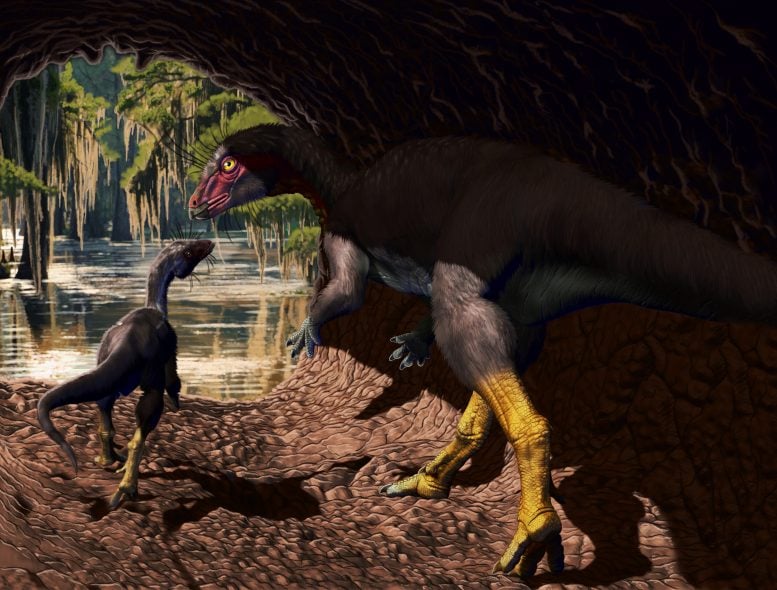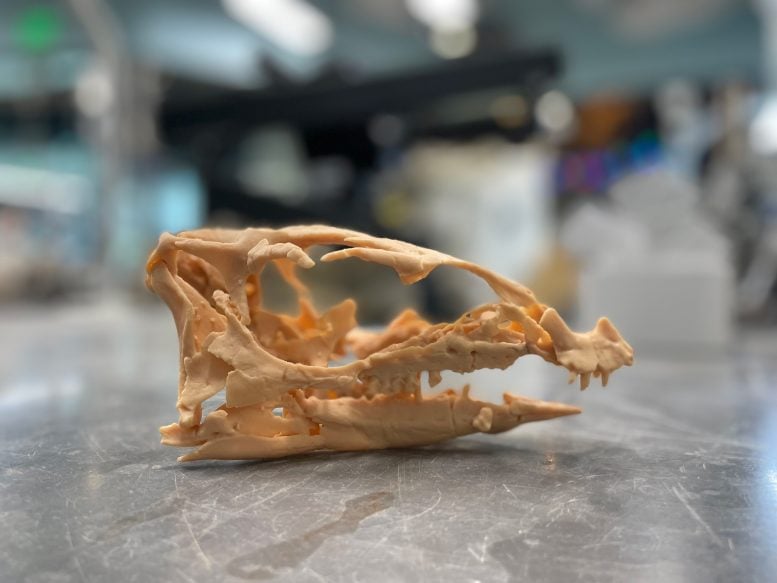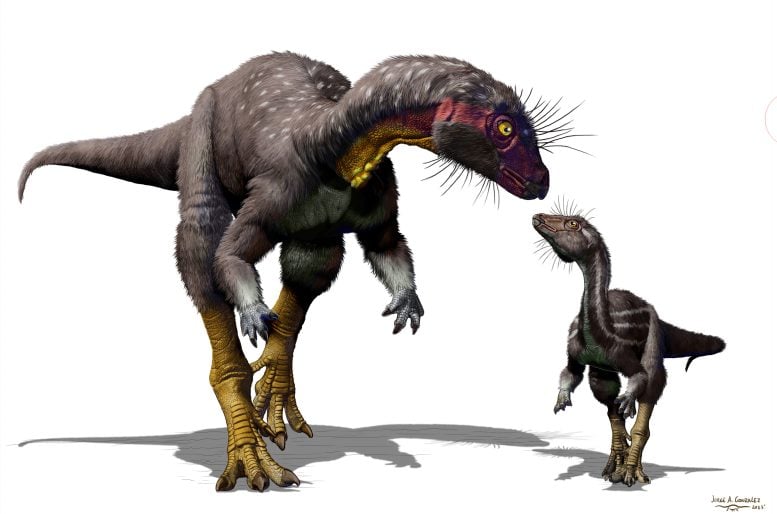
Fona herzogaeA dinosaur recently discovered in Utah likely lived partly underground, as evidenced by its anatomical adaptations and the frequent preservation of its fossils in burrows, reshaping our understanding of life in the Cretaceous. Credit: Jorge Gonzalez
The discovery of the burrowing dinosaur, Fona herzogae, from the middle of the
” data-gt-translate-attributes=”({“attribute”:”data-cmtooltip”, “format”:”html”})” tabindex=”0″ role=”link”>Cretaceous This period reveals a complex ecosystem in which dinosaurs occupied subterranean niches. This highlights the diversity and ecological adaptability of dinosaurs, expanding our understanding of their roles in ancient environments.
The age of dinosaurs didn’t just happen above ground. A newly discovered ancestor Thescelosaurus reveals that these animals spent part of their time in underground burrows. This new
” data-gt-translate-attributes=”({“attribute”:”data-cmtooltip”, “format”:”html”})” tabindex=”0″ role=”link”>species contributes to our understanding of life during the Middle Cretaceous, both above and below ground.
The new dinosaur, Background (/Foat’NAH/) herzogae 99 million years ago, people inhabited the region in what is now Utah. At that time, the region was a vast floodplain ecosystem wedged between the shores of a vast inland ocean to the east and active volcanoes and mountains to the west. It was a hot, humid, muddy environment, with many rivers flowing through it.
Paleontologists from
” data-gt-translate-attributes=”({“attribute”:”data-cmtooltip”, “format”:”html”})” tabindex=”0″ role=”link”>North Carolina State University and the North Carolina Museum of Natural Sciences unearthed the fossil — and others of the same species — from the Mussentuchit Member of the Cedar Mountain Formation, beginning in 2013. The preservation of these fossils, along with some distinctive features, alerted them to the possibility of burrowing.
Physical characteristics and signs of digging
Background was a small, herbivorous dinosaur about the size of a large dog with a simple body plan. It lacks the bells and whistles that characterize its highly ornamented relatives such as horned dinosaurs, armored dinosaurs, and crested dinosaurs. But that doesn’t mean Background was boring.
Background The common scorpion shares several anatomical features with animals known to dig or burrow, such as large biceps muscles, strong muscle attachment points on the hips and legs, fused bones along the pelvis—likely to aid stability while digging—and hind limbs that are proportionally larger than the forelimbs. But that’s not the only evidence that this animal spent time underground.

3D printed Fona skull. Credit: Lindsay Zanno
“The fossil record favors larger animals, primarily because in floodplain environments like the Mussentuchit, small bones on the surface often scatter, rot, or are scavenged before being buried and fossilized,” says Haviv Avrahami, a doctoral student at North Carolina State University and a digital technician for the new Dueling Dinosaurs program at the North Carolina Museum of Natural Sciences. Avrahami is first author of the paper describing the work.
“But Background “It is often found complete, with many bones preserved in the initial position of death, chest down and forelimbs spread apart, and in an exceptional state of preservation,” Avrahami explains. “If it had already been buried in a burrow before its death, this type of preservation would have been more likely.”
Lindsay Zanno, associate research professor at North Carolina State University, chair of paleontology at the North Carolina Museum of Natural Sciences and corresponding author of the book, agrees.
“Background “Skeletons are much more common in this area than you might think for a small animal with fragile bones,” Zanno says. “The best explanation for why we find so many of them and collect them in small groups of several individuals is that they lived at least part of the time underground. In fact, Fona did most of the work for us, burrowing all over this area.”
Although researchers have not yet identified the underground burrows of Backgroundthe tunnels and the room of his closest relative, Oryctodromeushave been found in Idaho and Montana. These findings support the idea that Background They also used burrows.

Fona herzogae. Credit: Jorge González
Cultural and scientific importance of Fona
The name of the genus Background The species name comes from the ancestral creation story of the Chamorro people, who are the indigenous people of Guam and the Pacific Mariana Islands. Fo’na and Pontan were brother and sister explorers who discovered the island and became the land and sky. The species name honors Lisa Herzog, paleontology operations manager at the North Carolina Museum of Natural Sciences, for her invaluable contributions and dedication to the field of paleontology.
“I wanted to pay homage to the indigenous mythology of Guam, where my Chamorro ancestors come from,” Avrahami explains. “In the myth, Fo’na became part of the earth when she died, and from her body a new life was born, which, for me, is connected to fossilization, beauty, and creation.” Background was probably covered with a downy coat of colorful feathers. The species name is that of Lisa Herzog, who played a key role in all this work and discovered one of the most exceptional specimens Background specimens of several individuals preserved together in what was probably a burrow.
Background is also a distant relative of another famous North Carolina fossil: Willo, a Thescelosaurus has been neglected specimen currently housed at the museum and also thought to exhibit adaptations for a semi-fossorial — or partially subterranean — lifestyle, research that was published in late 2023 by Zanno and former NC State postdoctoral researcher David Button.
” T. neglected was at the end of this line – Background “This is its ancestor from about 35 million years ago,” Avrahami explains.
Researchers believe Background is essential to expand our understanding of Cretaceous ecosystems.
“Background “This gives us a glimpse into the third dimension that an animal can occupy while moving underground,” Avrahami says. “It adds to the richness of the fossil record and expands the known diversity of small-bodied herbivores, which remain poorly understood despite being incredibly essential components of Cretaceous ecosystems.”
“People tend to have a myopic view of dinosaurs that hasn’t kept up with the evolution of science,” Zanno says. “We now know that dinosaur diversity ranged from tiny tree-dwelling gliders and nocturnal hunters to sloth-like grazers and even subterranean dwellings.”
Reference: “A new semi-fossorial thescelosaurine dinosaur from the Cenomanian Mussentuchit Member of the Cedar Mountain Formation, Utah” by Haviv M. Avrahami, Peter J. Makovicky, Ryan T. Tucker, and Lindsay E. Zanno, July 9, 2024, The anatomical file.
DOI: 10.1002/ar.25505